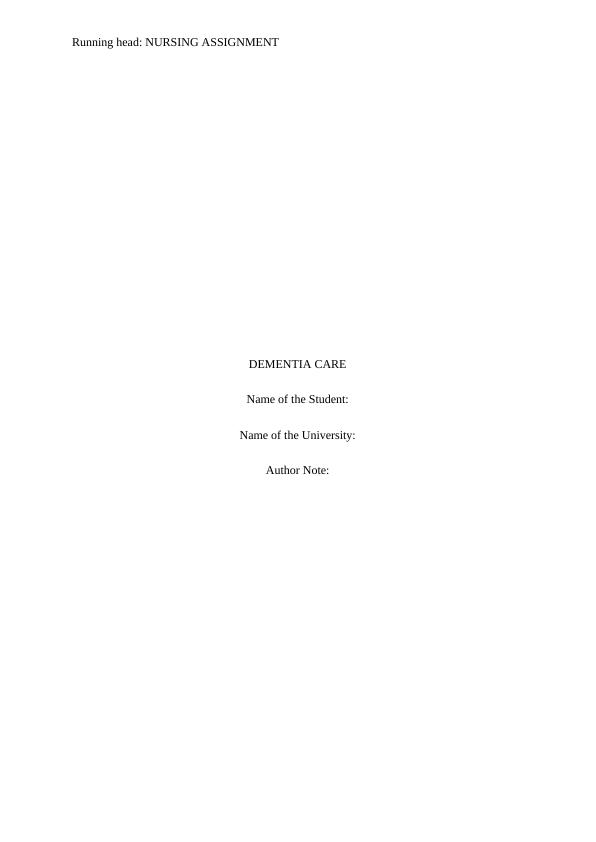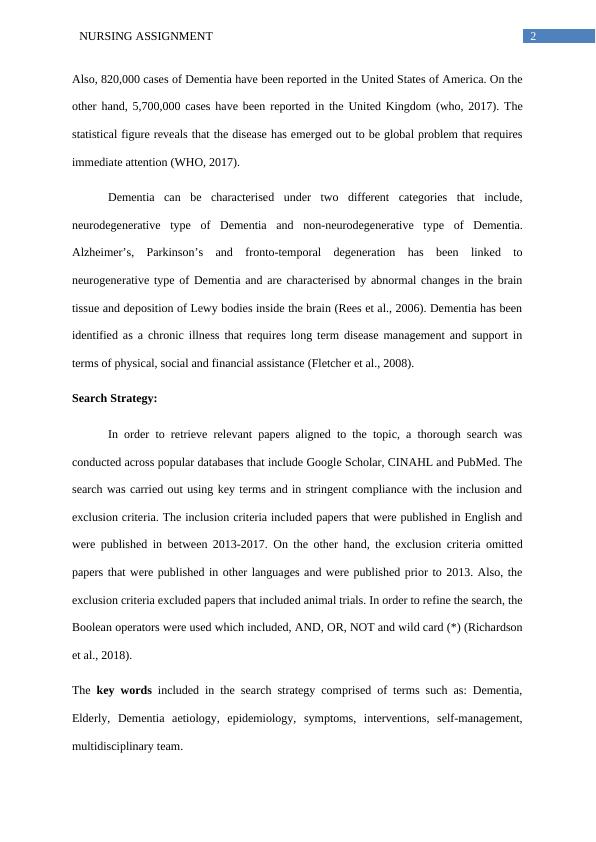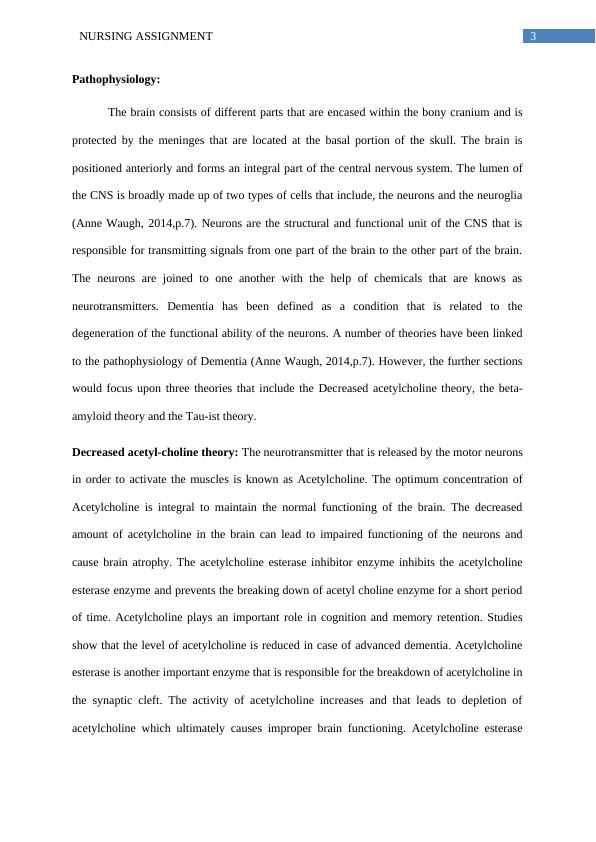Dementia Care: Symptoms, Pathophysiology, and MMSE Assessment Tool
Added on 2023-05-28
19 Pages5501 Words339 Views
Running head: NURSING ASSIGNMENT
DEMENTIA CARE
Name of the Student:
Name of the University:
Author Note:
DEMENTIA CARE
Name of the Student:
Name of the University:
Author Note:

1NURSING ASSIGNMENT
Introduction:
Dementia can be defined as a condition that interferes with the normal functioning of
the brain. The medical condition is primarily characterized by cognitive impairment, memory
loss and inability to perform activities of daily living (Rees et al., 2006). It should be noted in
this context that the term Dementia is not used to denote a specific disorder but is used for a
wide group of symptoms. The symptoms are tightly linked with memory impairment and
decreased independence to manage the activities of daily living. On an approximate basis,
60% to 80% of the Dementia cases are directly linked to Alzheimer’s disease (Alzheimer’s
Association, 2016). It should further be mentioned in this regard that Vascular Dementia
accounts for the second most common type of Dementia that manifests itself after a stroke. In
addition to this, it should be stated in this regard that, vitamin deficiencies and thyroxin
hormone imbalance can also lead to Dementia (Alzheimer’s Association, 2016). A prevalent
belief predicts that the probability to develop Dementia rapidly increases with an advancing
age, however it should be noted in this regard that the notion does not hold true and is not
backed up by evidences.
Dementia, however has emerged out to be a global problem in context of the
developing countries. Considering the seriousness of the condition, the developed as well the
developing nations of the world have increased the budget for Dementia and disease
management in order to render positive patient outcome. In compliance with the statistical
evidences it can be stated that more than 50 million people worldwide suffer from Dementia
(Alzheimer’s Association, 2016). Further, it should also be noted that 1 out of 10 people aged
60 years and above suffer from Dementia in Singapore (Alzheimer’s Association, 2016).
Studies have predicted that the number of patients suffering from Dementia might go up from
25,000 as estimated in the year 2015 up to 53,000 by the end of the year 2020 (WHO, 2017).
Introduction:
Dementia can be defined as a condition that interferes with the normal functioning of
the brain. The medical condition is primarily characterized by cognitive impairment, memory
loss and inability to perform activities of daily living (Rees et al., 2006). It should be noted in
this context that the term Dementia is not used to denote a specific disorder but is used for a
wide group of symptoms. The symptoms are tightly linked with memory impairment and
decreased independence to manage the activities of daily living. On an approximate basis,
60% to 80% of the Dementia cases are directly linked to Alzheimer’s disease (Alzheimer’s
Association, 2016). It should further be mentioned in this regard that Vascular Dementia
accounts for the second most common type of Dementia that manifests itself after a stroke. In
addition to this, it should be stated in this regard that, vitamin deficiencies and thyroxin
hormone imbalance can also lead to Dementia (Alzheimer’s Association, 2016). A prevalent
belief predicts that the probability to develop Dementia rapidly increases with an advancing
age, however it should be noted in this regard that the notion does not hold true and is not
backed up by evidences.
Dementia, however has emerged out to be a global problem in context of the
developing countries. Considering the seriousness of the condition, the developed as well the
developing nations of the world have increased the budget for Dementia and disease
management in order to render positive patient outcome. In compliance with the statistical
evidences it can be stated that more than 50 million people worldwide suffer from Dementia
(Alzheimer’s Association, 2016). Further, it should also be noted that 1 out of 10 people aged
60 years and above suffer from Dementia in Singapore (Alzheimer’s Association, 2016).
Studies have predicted that the number of patients suffering from Dementia might go up from
25,000 as estimated in the year 2015 up to 53,000 by the end of the year 2020 (WHO, 2017).

2NURSING ASSIGNMENT
Also, 820,000 cases of Dementia have been reported in the United States of America. On the
other hand, 5,700,000 cases have been reported in the United Kingdom (who, 2017). The
statistical figure reveals that the disease has emerged out to be global problem that requires
immediate attention (WHO, 2017).
Dementia can be characterised under two different categories that include,
neurodegenerative type of Dementia and non-neurodegenerative type of Dementia.
Alzheimer’s, Parkinson’s and fronto-temporal degeneration has been linked to
neurogenerative type of Dementia and are characterised by abnormal changes in the brain
tissue and deposition of Lewy bodies inside the brain (Rees et al., 2006). Dementia has been
identified as a chronic illness that requires long term disease management and support in
terms of physical, social and financial assistance (Fletcher et al., 2008).
Search Strategy:
In order to retrieve relevant papers aligned to the topic, a thorough search was
conducted across popular databases that include Google Scholar, CINAHL and PubMed. The
search was carried out using key terms and in stringent compliance with the inclusion and
exclusion criteria. The inclusion criteria included papers that were published in English and
were published in between 2013-2017. On the other hand, the exclusion criteria omitted
papers that were published in other languages and were published prior to 2013. Also, the
exclusion criteria excluded papers that included animal trials. In order to refine the search, the
Boolean operators were used which included, AND, OR, NOT and wild card (*) (Richardson
et al., 2018).
The key words included in the search strategy comprised of terms such as: Dementia,
Elderly, Dementia aetiology, epidemiology, symptoms, interventions, self-management,
multidisciplinary team.
Also, 820,000 cases of Dementia have been reported in the United States of America. On the
other hand, 5,700,000 cases have been reported in the United Kingdom (who, 2017). The
statistical figure reveals that the disease has emerged out to be global problem that requires
immediate attention (WHO, 2017).
Dementia can be characterised under two different categories that include,
neurodegenerative type of Dementia and non-neurodegenerative type of Dementia.
Alzheimer’s, Parkinson’s and fronto-temporal degeneration has been linked to
neurogenerative type of Dementia and are characterised by abnormal changes in the brain
tissue and deposition of Lewy bodies inside the brain (Rees et al., 2006). Dementia has been
identified as a chronic illness that requires long term disease management and support in
terms of physical, social and financial assistance (Fletcher et al., 2008).
Search Strategy:
In order to retrieve relevant papers aligned to the topic, a thorough search was
conducted across popular databases that include Google Scholar, CINAHL and PubMed. The
search was carried out using key terms and in stringent compliance with the inclusion and
exclusion criteria. The inclusion criteria included papers that were published in English and
were published in between 2013-2017. On the other hand, the exclusion criteria omitted
papers that were published in other languages and were published prior to 2013. Also, the
exclusion criteria excluded papers that included animal trials. In order to refine the search, the
Boolean operators were used which included, AND, OR, NOT and wild card (*) (Richardson
et al., 2018).
The key words included in the search strategy comprised of terms such as: Dementia,
Elderly, Dementia aetiology, epidemiology, symptoms, interventions, self-management,
multidisciplinary team.

3NURSING ASSIGNMENT
Pathophysiology:
The brain consists of different parts that are encased within the bony cranium and is
protected by the meninges that are located at the basal portion of the skull. The brain is
positioned anteriorly and forms an integral part of the central nervous system. The lumen of
the CNS is broadly made up of two types of cells that include, the neurons and the neuroglia
(Anne Waugh, 2014,p.7). Neurons are the structural and functional unit of the CNS that is
responsible for transmitting signals from one part of the brain to the other part of the brain.
The neurons are joined to one another with the help of chemicals that are knows as
neurotransmitters. Dementia has been defined as a condition that is related to the
degeneration of the functional ability of the neurons. A number of theories have been linked
to the pathophysiology of Dementia (Anne Waugh, 2014,p.7). However, the further sections
would focus upon three theories that include the Decreased acetylcholine theory, the beta-
amyloid theory and the Tau-ist theory.
Decreased acetyl-choline theory: The neurotransmitter that is released by the motor neurons
in order to activate the muscles is known as Acetylcholine. The optimum concentration of
Acetylcholine is integral to maintain the normal functioning of the brain. The decreased
amount of acetylcholine in the brain can lead to impaired functioning of the neurons and
cause brain atrophy. The acetylcholine esterase inhibitor enzyme inhibits the acetylcholine
esterase enzyme and prevents the breaking down of acetyl choline enzyme for a short period
of time. Acetylcholine plays an important role in cognition and memory retention. Studies
show that the level of acetylcholine is reduced in case of advanced dementia. Acetylcholine
esterase is another important enzyme that is responsible for the breakdown of acetylcholine in
the synaptic cleft. The activity of acetylcholine increases and that leads to depletion of
acetylcholine which ultimately causes improper brain functioning. Acetylcholine esterase
Pathophysiology:
The brain consists of different parts that are encased within the bony cranium and is
protected by the meninges that are located at the basal portion of the skull. The brain is
positioned anteriorly and forms an integral part of the central nervous system. The lumen of
the CNS is broadly made up of two types of cells that include, the neurons and the neuroglia
(Anne Waugh, 2014,p.7). Neurons are the structural and functional unit of the CNS that is
responsible for transmitting signals from one part of the brain to the other part of the brain.
The neurons are joined to one another with the help of chemicals that are knows as
neurotransmitters. Dementia has been defined as a condition that is related to the
degeneration of the functional ability of the neurons. A number of theories have been linked
to the pathophysiology of Dementia (Anne Waugh, 2014,p.7). However, the further sections
would focus upon three theories that include the Decreased acetylcholine theory, the beta-
amyloid theory and the Tau-ist theory.
Decreased acetyl-choline theory: The neurotransmitter that is released by the motor neurons
in order to activate the muscles is known as Acetylcholine. The optimum concentration of
Acetylcholine is integral to maintain the normal functioning of the brain. The decreased
amount of acetylcholine in the brain can lead to impaired functioning of the neurons and
cause brain atrophy. The acetylcholine esterase inhibitor enzyme inhibits the acetylcholine
esterase enzyme and prevents the breaking down of acetyl choline enzyme for a short period
of time. Acetylcholine plays an important role in cognition and memory retention. Studies
show that the level of acetylcholine is reduced in case of advanced dementia. Acetylcholine
esterase is another important enzyme that is responsible for the breakdown of acetylcholine in
the synaptic cleft. The activity of acetylcholine increases and that leads to depletion of
acetylcholine which ultimately causes improper brain functioning. Acetylcholine esterase

End of preview
Want to access all the pages? Upload your documents or become a member.
Related Documents
Risk Factors for Dementia in Elderly Patients in the UKlg...
|13
|3819
|498
HNB3209 - Report on Nursing and The Communitylg...
|12
|3009
|98
Nursing Essay in Dementia: Evidence Based Practice and Caregiver Managementlg...
|8
|2518
|346
Assignment on the Mental Health Nursinglg...
|8
|1884
|73
Nursing Assignment on Cognitive Disorder and Dementialg...
|3
|514
|366
Management of Chronic Disease: Alzheimer's Disease and Dementialg...
|16
|5859
|388
